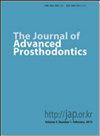一种新的牙科扫描系统评估参考模型——对五种口腔内扫描仪的分析
IF 2.7
3区 医学
Q1 DENTISTRY, ORAL SURGERY & MEDICINE
引用次数: 2
摘要
本体外研究的目的是使用一种新的标准化性能评估参考模型,研究五种口腔内扫描仪(IOS)的准确性(真实性和精密度)。材料和方法使用五个IOS(Medit i500、Omnicam、Primescan、Trios 3、Trios 4)对参考模型进行数字化,该参考模型代表了四颗基牙的简化全弓情况。每个IOS由一位经验丰富的操作员使用了五次,生成了25个STL(标准细分语言)文件。STL数据被导入3D软件(Final Surface®),并进行组间和组内分析。计算了参数匹配误差的偏差。采用方差分析F检验和Kruskal-Wallis检验进行组间比较(α=0.05);并计算组内比较的变异系数(CV)(单位为%±SD)。结果Primescan(匹配误差值:0.015)、Trios 3(0.016)和Trios 4(0.018)显示的可比结果与Medit i500(0.035)和Omnicam(0.028)相比具有显著更高的准确性(P<.001)。对于组内比较,Trios4显示出最均匀的结果(CV15.8%)。结论本研究中研究的新参考模型可用于评估牙科扫描技术在日常和研究环境中的性能。本文章由计算机程序翻译,如有差异,请以英文原文为准。
A novel reference model for dental scanning system evaluation: analysis of five intraoral scanners
PURPOSE The aim of this in vitro study was to investigate the accuracy (trueness and precision) of five intraoral scanners (IOS) using a novel reference model for standardized performance evaluation. MATERIALS AND METHODS Five IOSs (Medit i500, Omnicam, Primescan, Trios 3, Trios 4) were used to digitize the reference model, which represented a simplified full-arch situation with four abutment teeth. Each IOS was used five times by an experienced operator, resulting in 25 STL (Standard Tessellation Language) files. STL data were imported into 3D software (Final Surface®) and examined for inter- and intra-group analyses. Deviations in the parameter matching error were calculated. ANOVA F-test and Kruskal-Wallis test were applied for inter-group comparisons (α = .05); and the coefficient of variation (CV) was calculated for intra-group comparisons (in % ± SD). RESULTS Primescan (matching error value: 0.015), Trios 3 (0.016), and Trios 4 (0.018) revealed comparable results with significantly higher accuracy compared to Medit i500 (0.035) and Omnicam (0.028) (P < .001). For intra-group comparison, Trios 4 demonstrated the most homogenous results (CV 15.8%). CONCLUSION The novel reference model investigated in this study can be used to assess the performance of dental scanning technologies in the daily routine setting and in research settings.
求助全文
通过发布文献求助,成功后即可免费获取论文全文。
去求助
来源期刊

Journal of Advanced Prosthodontics
DENTISTRY, ORAL SURGERY & MEDICINE-
CiteScore
4.70
自引率
3.80%
发文量
25
期刊介绍:
This journal aims to convey scientific and clinical progress in the field of prosthodontics and its related areas to many dental communities concerned with esthetic and functional restorations, occlusion, implants, prostheses, and biomaterials related to prosthodontics.
This journal publishes
• Original research data of high scientific merit in the field of diagnosis, function, esthetics and stomatognathic physiology related to prosthodontic rehabilitation, physiology and mechanics of occlusion, mechanical and biologic aspects of prosthodontic materials including dental implants.
• Review articles by experts on controversies and new developments in prosthodontics.
• Case reports if they provide or document new fundamental knowledge.
 求助内容:
求助内容: 应助结果提醒方式:
应助结果提醒方式:


